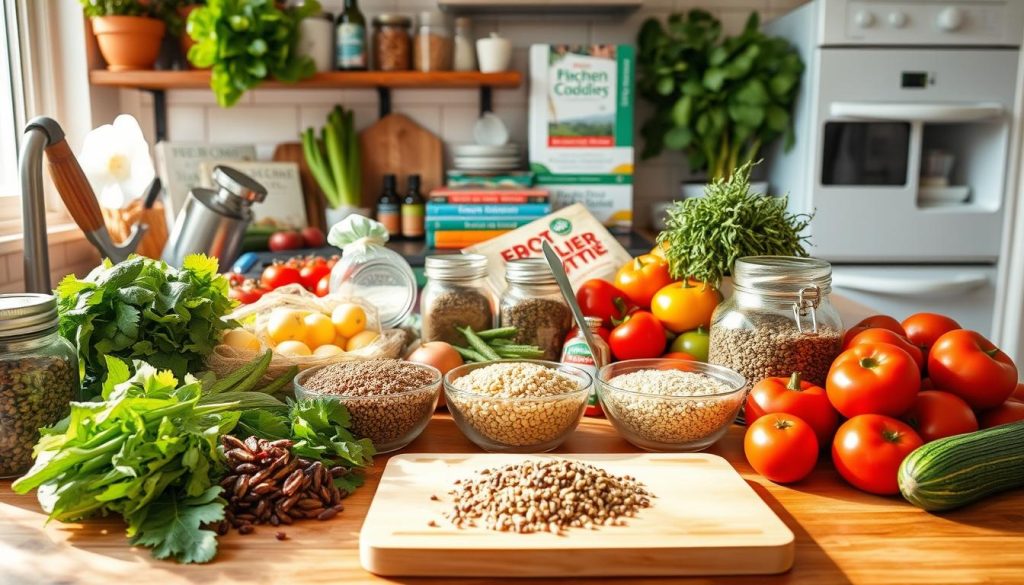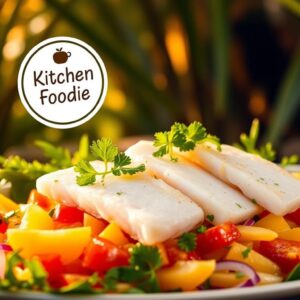Every kitchen has the power to help both people and the planet. Making small changes can have a big impact. Our guide offers practical tips and cookbook recipes for busy cooks. Let’s make your kitchen a place of eco-conscious cooking without losing flavor.
Did you know 70% of U.S. food waste is preventable? Simple actions like meal planning and composting can help. Using cast iron or stainless steel cookware also cuts waste and energy. Over 400 growers work with Natoora to bring you ethically sourced ingredients, showing you can be sustainable without losing taste or convenience.
Start with Melissa Hemsley’s Eat Green, a 2020 cookbook with 100 recipes that turn “waste” into meals. Her “Rescue Noodle Soup” uses leftover veggies, and “Fridge-Raid Frittata” turns odds and ends into tasty dishes. These cookbook recipes show how to cook from root to stem, using carrot tops and herb stems.
Join the zero-waste movement by using reusable cloths and beeswax wraps instead of paper towels and plastic wrap. Cutting single-use coffee pods (50% of coffee waste comes from K-cups) and buying local produce within 100 miles also helps. Every choice, from composting to smart shopping, makes your kitchen better for the planet and your wallet.
The Environmental Impact of Your Kitchen Choices
Every choice in the kitchen affects the planet. Food waste is a big problem, causing 8% of global greenhouse gases. In the U.S., 40% of food is thrown away each year, costing families $1,500 annually. Choosing sustainable cookbook recipes and healthy meal recipes can help.
Using modern appliances saves energy. Eating less meat also helps, as beef has a huge environmental impact. Beans, on the other hand, have a much smaller footprint.
Small changes can make a big difference. Planning meals can reduce waste by 30%. Using scraps for meals, like broth from vegetable scraps, is another way to cut down on waste.
Choosing seasonal ingredients lowers emissions by 30%. Reducing food waste could also cut emissions by 8-10%. Even simple steps, like mastering seasoning, can help use ingredients better. Let’s look at ways to make every meal more sustainable.
Essential Tools for an Eco-Friendly Kitchen
Starting an eco-friendly kitchen means choosing the right tools. A sharp chef’s knife is key, as dull blades cause most kitchen injuries. Get a versatile knife set and a strong cutting board for safer prep.
Cast-iron skillets and stainless steel pans last long and cook better than disposable ones. For easy dinner ideas, a high-powered blender like Vitamix is great. It blends tough ingredients easily with its tamper tool.
Silicone baking mats make cleanup easy and last over four years. Use glass storage containers like mason jars to avoid single-use plastics. Beeswax wraps and Swedish dishcloths cut down on paper and plastic use.
A pressure cooker saves time and energy, cooking beans and grains fast. It uses 70% less energy than old methods.
Small changes like Food Huggers or reusable bags help store leftovers. These small steps can reduce household waste by 20%. With the right tools, cooking sustainably becomes simple. Start with a few items and watch your kitchen and the planet benefit.
Sustainable Food Shopping: From Market to Pantry
Starting a sustainable pantry begins with the source. Fresh, locally grown ingredients make seasonal recipes shine. Shopping at farmers’ markets helps reduce emissions by 11% from transport.
Seasonal recipes also taste better and are more nutritious. This is because produce travels less from farm to table.
Understanding labels is key. USDA Organic means no synthetic pesticides. The EWG’s Dirty Dozen list tells you which crops to buy organic.
Bring your own jars and cloth bags to cut down on plastic. Stores like Thrive Market now offer package-free grains and spices for zero-waste shopping.
Meal planning reduces waste. Plan meals around what’s in season, like winter squash or summer berries. Freeze what you can’t use right away.
Carleigh Bodrug’s PlantYou Scrappy Cooking shows how to make meals from scraps. Use every part of a vegetable, like beet-and-lentil stews. Store onions in mesh bags and greens in airtight containers to keep them fresh longer.
Reducing meat intake by 15% can lower your foodprint. Choose seasonal legumes and grains for protein. Seasonal meal planning saves money too, cutting grocery bills by up to 25%.
Every choice, from picking seasonal produce to learning how to store it, makes your pantry more sustainable and practical.
Energy-Efficient Cooking Methods to Reduce Your Carbon Footprint
Every meal we make is a chance to use less energy and help the planet. Using smart cooking methods like pressure cooking can cut energy use by up to 70%. Even simple actions like matching pot sizes to stove burners or using lids can save a lot. Let’s see how these tips can change your kitchen habits.
Begin your day with eco-friendly quick breakfast recipes like overnight oats or egg cups. These recipes need little cooking—just mix ingredients the night before. Pressure cookers make big meals fast, and cast iron pans keep heat well, saving 20% energy. For more ideas, check out “Cooking Green” for over 50 recipes that are good for the planet.
Batch cooking and using slow-cookers save time and energy. Try Mediterranean Rice Paper Rolls, a dish that doesn’t need cooking. Small changes like thawing food in the fridge instead of the microwave or using convection ovens help too. By doing these things, we make cooking a way to help the environment without losing flavor or convenience.
Eco-Conscious Cookbook Recipes for Everyday Meals
Our cookbook recipes show you can eat sustainably without losing flavor or convenience. Start your day with overnight oats in reusable containers. This saves energy compared to stovetop cooking.
Frittatas filled with fresh veggies are great for using up leftovers. They’re also easy to make.
For lunch, try grain bowls with fresh produce and beans. They’re perfect for packing in containers, reducing takeout waste. Use last night’s dinner in new ways, like turning roasted veggies into salads or soups.
Our evening meals are flexible. They offer options for both meat lovers and vegetarians. Our vegetarian recipes are made for batch cooking, saving time and energy. You can also swap ingredients based on what’s in season or what you already have.
We’ve tested our methods to fit busy lives. Small changes, like using local greens or freezing leftovers, make a big difference. Cooking this way is good for the planet and opens up new flavors. It also helps reduce waste.
Plant-Forward Eating: Delicious Vegetarian Recipes for Meat-Lovers
Switching to plant-based meals doesn’t mean you have to give up taste or satisfaction. Our vegetarian recipes use ingredients like mushrooms and roasted tomatoes to add depth. Try lentil and vegetable stew with crusty bread for a filling meal.
For a quick dinner, make black bean burgers with smoked paprika and avocado crema. These healthy meal recipes are packed with protein and fiber. Studies show they can lower heart disease risk by up to 32%.
Give classic lasagna a new twist with cashew ricotta and roasted eggplant. Use garlic, nutritional yeast, and fresh herbs for layered flavors. Add roasted Brussels sprouts or sweet potatoes for natural sweetness.
Even small changes can make a big difference. Our vegetarian recipes include dishes like meat-reduced chili. By 2027, the plant-based market is expected to reach $74.2 billion, showing it’s both popular and delicious.
Check out “Six Seasons” or “The Moosewood Cookbook” for more ideas. They focus on global flavors and seasonal ingredients. With 23% more Americans choosing veggie burgers, it’s clear this trend is here to stay. Start with one dish a week to see how easy it is to make your kitchen more sustainable.
Seasonal Cooking: Making the Most of Nature’s Calendar
Seasonal cooking is more than a trend; it’s a way to enjoy food at its best. It helps local farmers and cuts down on kitchen waste. Our Modern Country Cooking cookbook has 75 seasonal recipes for every season.
Picture a salad full of July tomatoes or a winter stew with local roots. Our Modern Country Cooking book is filled with these ideas. Wendy E. Cook, a nutrition expert, created these recipes to show off the best flavors and cut down on waste.
Preserving food lets us enjoy it all year. Freeze summer berries for winter smoothies or make tangy kimchi from fall veggies. We share how to can, dehydrate, and ferment in our Salt Water Farm kitchen.
Every area has its own food rhythm. Our online library has guides for peak produce in every U.S. region. Try asparagus with lemon in spring or winter squash in soups. These changes save money and reduce food miles.
From Scraps to Sensational: Creative Ways to Use Food “Waste”
Did you know 30-40% of U.S. food goes to waste, costing households up to $1,800 annually? Turning scraps into meals is smart and eco-friendly. It helps stretch your grocery budget. Let’s explore what’s possible with what’s often thrown away.
Begin with basics like making vegetable stocks from carrot tops and onion ends. Citrus peels can be zesty marmalades or frozen zest for baking. Check out Foodal’s guide for more tips. Even stale bread can become crunchy croutons or breadcrumbs.
Both professional chefs and home cooks are embracing this trend. Carleigh Bodrug’s PlantYou: Scrappy Cooking shows creativity in using scraps. Try making slaw from broccoli stems or regrowing celery in under two weeks. These methods save money and reduce waste, fitting perfectly with budget-friendly meals that taste like gourmet dishes.
Small actions can make a big impact. Coffee grounds can clean counters, and eggshells add calcium to soups. By using scraps, families reduce landfill waste and save hundreds each year. Every vegetable peel, herb stem, or leftover porridge can lead to new recipes. This shows that sustainability and affordability can go together.
Budget-Friendly Sustainability: Eco-Cooking on a Dime
Going green doesn’t have to cost a lot. Sustainable cooking and affordable meals go together. Many eco-friendly habits also save money and reduce waste.
Dried beans are 70% cheaper than canned beans and don’t come in single-use packaging. Cooking in bulk uses less energy. Leftovers can become tasty meals like soups or stir-fries.

Begin with a basic pantry: whole grains, legumes, and bulk spices. Choose seasonal veggies for better taste and lower cost. Plant proteins like beans, lentils, or quinoa are 56% cheaper than meat.
Our meal plans reuse ingredients, like carrot tops in stocks and carrot roots in salads. A bean casserole, for example, is very cheap but feeds many.
Smart shopping focuses on affordable organic items like spinach or broccoli. Use conventional fruits for thick skins. Meal prep saves time and money, like slow-cooker soups or freezer portions.
Even small actions, like freezing veggie scraps for broth, help. These steps can cut your grocery bill by 40% while cooking sustainably. Let’s show that eco-friendly eating is both possible and tasty.
Teaching Kids About Sustainable Food Through Fun Recipes
Get kids involved in the kitchen to teach them about sustainable food. Start with family-friendly recipes that show how to reduce waste and use local ingredients. Try making herb-infused pancakes or veggie peel crisps. These activities make learning about sustainability fun and tasty.
Start with that teach kids to be resourceful. Use overripe bananas to make muffins and turn veggie scraps into new plants. Growing herbs or regrowing lettuce from scraps teaches kids about food cycles. It’s fun to make buckwheat galettes with herbs they’ve grown themselves.
Give kids tasks that match their age to build their confidence. Preschoolers can help with washing veggies or tearing basil. Older kids can measure ingredients for flapjacks or make grain bowls with fresh produce. The Green Kids Cook book has 50+ recipes for kids aged 7+.
Teach kids about safety in the kitchen too. Show them how to wash hands and use knives safely. Use resources like Team Nutrition Cooks and Food Hero’s pita pizzas to make learning fun. By linking cooking to nature, kids learn to appreciate food and the planet.
Your Green Kitchen Journey: Small Changes, Big Impact
Every choice in your kitchen counts. Start with cookbook recipes that reduce waste or try family-friendly recipes for easier meals. Every step you take brings progress.
Begin with small changes like using reusable containers or setting up a compost bin. Swapping one meat meal a week can make a big difference over time.
Choose foods rich in nutrients like whole grains and seasonal vegetables. These are key in Zero-Waste Chef and Olives, Lemons, & Za’atar. Opt for small fish to help the ocean and enjoy tasty dishes like beet salads or harira soup.
Remember, most Americans don’t eat enough fruits and vegetables. Your kitchen can help fix that.
Connect with others by sharing tips, swapping ingredients, or hosting potlucks. Keep track of your progress with journals or apps. You’ll see how small changes, like using less oil or freezing leftovers, can make a big difference.
By adopting these habits, families can save money, enjoy better meals, and connect more with their food.
Begin today. Replace one single-use item, try a new vegetable dish, or join a local swap group. Every choice, from choosing sustainable seafood to mastering pantry staples, contributes to a greener future. Your kitchen is more than just a place for meals—it’s where you create a healthier world.
Source Links
- https://coolmomeats.com/2025/03/14/eco-friendly-sustainable-kitchen-tips/
- https://www.gradito.com/blog/how-to-embrace-sustainable-cooking-at-home-in-2024
- https://foodprint.org/blog/eco-friendly-cooking-eat-green-cookbook/
- https://www.wired.com/story/climate-cookbooks-are-here-to-change-how-you-eat/
- https://balancedkitchen.com/2024/07/sustainable-recipes/
- https://www.worldofvegan.com/kitchen-tools/
- https://nymag.com/strategist/article/best-eco-friendly-sustainable-kitchen-items-reusable.html
- https://zerowastechef.com/zero-waste-chef-cookbook/
- https://www.chefnischan.com/blog/the-sustainable-pantry
- https://foodprint.org/blog/sustainable-grocery-shopping/
- https://herfirst100k.com/financial-feminist-show-notes/how-to-lower-your-grocery-bill-and-stop-food-waste-with-carleigh-bodrug-replay/
- https://www.sheknows.com/food-and-recipes/articles/809028/energy-saving-recipes-reducing-your-carbon-footprint-in-the-kitchen/
- https://www.ocregister.com/2024/04/10/8-sustainable-and-eco-friendly-cooking-tips-to-save-the-planet/
- https://www.greenpan.us/blogs/the-cooks-journal/10-sustainable-cookbooks-to-help-you-reduce-food-waste
- https://theecologist.org/2011/jun/13/five-best-environmentally-friendly-cookbooks
- https://www.bonappetit.com/story/best-vegetarian-cookbooks?srsltid=AfmBOopzqtGv-gNOY2rr3uDL05FuGF4PC-zIw_d3VCc6fB_9GbBzXScY
- https://www.loveandlemons.com/plant-based-recipes/
- https://downeast.com/food-drink/springtime-recipes-modern-country-cooking/
- https://rudolfsteinerbookstore.com/product/biodynamic-food-and-cookbook/
- https://www.plantstrongpodcast.com/blog/scrappy-cooking-carleigh-bodrug
- https://gippslandunwrapped.com/2016/09/06/my-zero-food-waste-experiment/
- https://foodal.com/knowledge/how-to/reuse-food-remains/
- https://www.lowlyfood.com/how-to-eat-sustainably-on-a-budget/
- https://www.tasteofhome.com/collection/budget-friendly-dinners-that-are-big-on-taste/?srsltid=AfmBOorwTFhVT7rJ3LBOYq46a_k-wHBmO9qsutjCxkxtKYwp6t-WK8RG
- https://www.theschoolrun.com/green-cooking-kids-healthy-food-thats-good-planet
- https://www.nutrition.gov/topics/nutrition-life-stage/children/kids-kitchen
- https://food52.com/the-piglet/judgments/93-olives-lemons-za-atar-vs-green-kitchen-travels?srsltid=AfmBOoq5CT5ugocB-fve3P2wFNe6ufFxUZjcGpEdt-ILKBKRg0IFajSG
- https://www.goodreads.com/book/show/35457309












